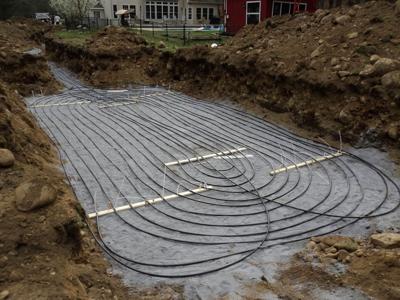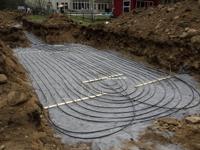Geothermal home heating and cooling systems cost more to install than conventional systems but the energy savings are immediate and the systems pay for themselves in as little as five years, according to manufacturers.
People also like geothermal because it uses no fossil fuels and has no carbon footprint.
John Ciovacco, president of Aztech Geothermal LLC in the Town of Ballston, Saratoga County, said the cost of installing a geothermal heating and cooling system is twice the cost of installing a conventional heating and cooling system. But there is a 30 percent federal tax credit for geothermal systems because of their zero impact on greenhouse gases and the payback in the system is in the five-year range, he said.
A constant 50
Geothermal heating and cooling systems take heat from the ground — down where it’s always 50 degrees — and convert it into heat or cooling for a home or business.
“We have to connect to the ground. Three quarters of the energy comes from the ground,” Ciovacco said.
The other one-quarter of the energy to make the system work comes in the form of the electricity needed for the heat pump to circulate water in the pipe system. The pump’s compressor heats the water from 50 degrees up to 150 degrees.
“The ground is always 50 degrees; that’s a lot warmer than zero [in the winter] or [cooler than] 90 degrees [on a hot summer day],” Ciovacco said. The system is able to “dump” the excess heat back into the underground system in the summer.
The geothermal system can be a vertical system that sends the pipe system down hundreds of feet into the ground or a horizontal system, in which the pipes are buried in loops about six feet underground. There is also a geothermal system that has the pipe loop installed at the bottom of a pond on a homeowner’s property.
An example of a successful geothermal system is the Clifton Park home of Paul and Joanne Coons. The Coons restored a 1830s Greek Revival house that was vacant and in major disrepair. They used all of the latest green technologies in the renovation that also had to adhere to town historic structure guidelines.
The Coons’ geothermal system is a 450-foot closed-loop vertical system that connects to a water-to-air geothermal heat pump.
Electricity for the system comes from a ground-mounted solar array located on their property. The combination of green building materials, geothermal heating and cooling, and the solar panels resulted in a net-zero-energy home that is so energy efficient its sells some power back to the local utility.
The installation of the Coons’ geothermal system cost about $22,000 but saves $2,400 per year in heating and air conditioning costs, according to a Green Builder magazine story on their project.
The Coons also power their two electric hybrid cars by plugging them into the home electrical system and still are able to sell back some power to the local utility. This home restoration was the 2012 overall grand winner in the magazine’s Green Home of the Year competition.
Aztech Geothermal is associated with Aztech Technologies Inc., an environmental services and remediation firm started in 1997.
Ciovacco said when Aztech Technologies built its building on McCrea Hill Road in 2006, it installed a geothermal system to heat and cool the building. Aztech Geothermal was started in 2008, when energy costs started increasing at an alarming rate.
“We have grown steadily since 2008,” Ciovacco said. He said the company installs about 50 geothermal systems in homes and businesses each year.
Ciovacco said 80 percent of the people ordering a geothermal system don’t have access to natural gas. Forty percent of these installations are new homes and 60 percent are retrofits to homes or businesses that previously used propane or oil to heat their structures.
If the installation is a forced-air heating and cooling system, the air ducts are the same as a conventional system. “Once it’s installed, it’s a closed system, like a closed refrigeration system,” Ciovacco said. He said there is less to clean and service and there is no outdoor equipment (other than the underground pipe system). “It’s all in the heat pump,” he said.
Federal tax credit
There is a 30 percent federal tax credit on geothermal systems to encourage a reduction in the country’s carbon footprint.
New York State is also considering tax incentives for geothermal installation similar to those given for solar energy systems.
More online
For information on geothermal energy, visit these websites:
• The New York Geothermal Energy Organization, ny-geo.org
• Aztech Geothermal, aztechgeo.com
Last year both the state Senate and Assembly passed bills calling for the state tax incentives for geothermal heating and cooling systems but Gov. Andrew Cuomo vetoed the legislation, said Bill Nowak, executive director of the New York Geothermal Energy Organization (NY-GEO).
The New York Geothermal Energy Organization is a nonprofit trade association dedicated to geothermal heating and cooling and includes geo designers, installers, manufacturers, drillers, consultants and distributors. Nowak and others are hoping that Cuomo will include the geothermal tax incentives in the state’s 2016-17 budget.
Last year, NY-GEO had its annual conference at Skidmore College in Saratoga Springs where approximately 40 percent of the campus is connected to geothermal cooling and heating systems.
Skidmore, a private liberal arts college, has two geothermal fields that support the heating and cooling of several college buildings: the Arts field that serves the Zankel Music Center, Filene Hall, Saisselin Art Building and Janet Kinghorn Bernhard Theater, said Andrea Wise, a college spokesperson. The second field covers the Wiecking residence hall and the Tang Teaching Center and Art Gallery.
There are another three stand-alone geothermal systems that serve the college’s Murray-Aikins Dining Hall, one for the 13-building Northwoods Village apartments, and one for the nine-building Sussman Village apartments, Wise said. The college was honored in 2012 with a Sustainability Leadership Award by the Association for the Advancement of Sustainability in Higher Education for its use of geothermal heating and cooling.
Wise said the college will start work on another geothermal field in mid-May that will support multiple buildings, including a planned Center for Integrated Sciences building and the current Dana Science Center. When this project is fully operational it would means the college would have between 50 and 55 percent geothermal coverage and even greater savings in its heating and cooling costs.
State officials like geothermal heating and cooling because its reduces the peak electrical energy load during summer heat waves. Geothermal systems are instrumental in meeting the state’s federal energy reduction requirements. At this year’s NY-GEO Conference, which will be held at the Radisson in Albany on April 19 and 20, the keynote speakers are John Rhodes, president and CEO of the New York State Energy Research and Development Authority (NYSERDA), and Audrey Zibelman, chair of the New York State Public Service Commission.
Nowak said there will also be workshops at the conference geared to designers, installers, architects, engineers, building owners and policy makers. The topic of the conference is “Breaking New Ground in Renewable Heating and Cooling.”
Nowak said his organization believes that geothermal heat pumps represent a heating and cooling technology that is essential for the country to meet the challenges of the 21st century.
The benefits include using the earth itself as a solar collector and energy storage system. The systems harvest renewable energy 24/7 without the need for a backup system and geothermal heat pump systems work to improve utility load factors while reducing peak demand.
“Moving heat stored in the ground and amplifying it with a geothermal heat pump can heat and cool an entire house or building without fossil fuels,” says a NY-GEO statement. “At the same time it lowers heating and cooling costs while reducing greenhouse gases that are linked to climate change,” says a NY-GEO statement.









